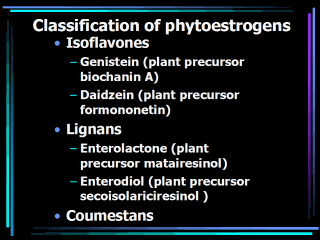 |
Most people think of soy when they hear the term
phytoestrogens. This view is simplistic as there are several classes of
phytoestrogens, each having fairly specific food sources, including those
other than soy. The main classes of phytoestrogens are isoflavones which
includes genistein and daidzein, the mammalian lignans enterolactone and
enterodiol, and coumestans. There are other phytochemicals that may also
have some estrogenic potential, but I will mainly be discussing isoflavones
and lignans. Genistein, daidzein, enterolactone, and enterodiol are the
metabolites of these plant precursors and can be measured in mammalian
fluids. Genistein and daidzein are metabolized from their plant precursors
biochanin A and formononetin and the lignans enterolactone and enterodiol
from the plant precursors matairesinol and secoisolariciresinol. Isoflavones
are present in plants in the bound glycoside form, but become active after
removal of the sugar residue. Fermentation by intestinal bacteria renders
them liable to absorption. They are measurable in serum, and excreted and
measurable in the urine. Lignans exist as minor constituents of many plants
and form the building blocks for lignins in the plant cell walls. Plant
lignans are metabolized in the mammalian gut to form the mammalian lignans
enterolactone and enterodiol. Metabolism and reabsorption of the mammalian
lignans can be affected by anything that affects the gut, such as antibiotic
use, or constipation. |
